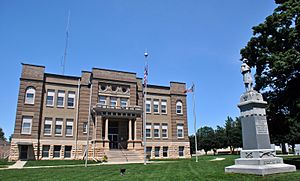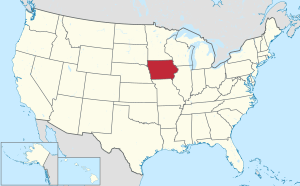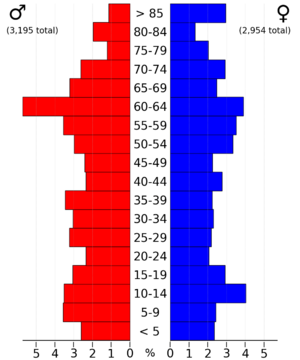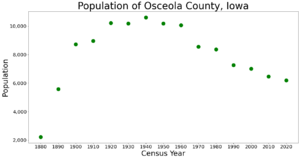Osceola County, Iowa facts for kids
Quick facts for kids
Osceola County
|
|
|---|---|

Osceola County Courthouse, July 2014
|
|

Location within the U.S. state of Iowa
|
|
 Iowa's location within the U.S. |
|
| Country | |
| State | |
| Founded | 1871 |
| Named for | Osceola |
| Seat | Sibley |
| Largest city | Sibley |
| Area | |
| • Total | 399 sq mi (1,030 km2) |
| • Land | 399 sq mi (1,030 km2) |
| • Water | 0.7 sq mi (2 km2) 0.2% |
| Population
(2020)
|
|
| • Total | 6,192 |
| • Density | 15.519/sq mi (5.992/km2) |
| Time zone | UTC−6 (Central) |
| • Summer (DST) | UTC−5 (CDT) |
| Congressional district | 4th |
Osceola County (/ˌɒsiˈoʊlə/ OSS-ee-OH-lə) is a county located in the U.S. state of Iowa. As of the 2020 census the population was 6,192, making it the state's fifth-least populous county. It is named for Seminole war chief Osceola. The county seat is Sibley, named for H. H. Sibley of Minnesota.
Contents
History
Osceola County was formed in 1871. It was named after the eponymous chief of the Seminole. It is the smallest and most recent county in Iowa. In the same year the first settler arrived, Captain Eldred Huff, and laid his claim. On January 1, 1872, the county government conferred for the first time. The first courthouse, constructed of wood, was built in November of the following year and simultaneously served as the conference chamber, school and church. In September 1903, the second courthouse was finished and was wired for electricity in October 1915.
Geography
According to the U.S. Census Bureau, the county has a total area of 399 square miles (1,030 km2), of which 399 square miles (1,030 km2) is land and 0.7 square miles (1.8 km2) (0.2%) is water. It is the third-smallest county in Iowa by land area and smallest by total area. The highest natural point in Iowa, Hawkeye Point at 1,670 feet (510 m), is located in Osceola County.
Major highways
Adjacent counties
- Nobles County, Minnesota (northwest)
- Jackson County, Minnesota (northeast)
- Dickinson County (east)
- O'Brien County (south)
- Lyon County (west)
Demographics
| Historical population | |||
|---|---|---|---|
| Census | Pop. | %± | |
| 1880 | 2,219 | — | |
| 1890 | 5,574 | 151.2% | |
| 1900 | 8,725 | 56.5% | |
| 1910 | 8,956 | 2.6% | |
| 1920 | 10,223 | 14.1% | |
| 1930 | 10,182 | −0.4% | |
| 1940 | 10,607 | 4.2% | |
| 1950 | 10,181 | −4.0% | |
| 1960 | 10,064 | −1.1% | |
| 1970 | 8,555 | −15.0% | |
| 1980 | 8,371 | −2.2% | |
| 1990 | 7,267 | −13.2% | |
| 2000 | 7,003 | −3.6% | |
| 2010 | 6,462 | −7.7% | |
| 2020 | 6,192 | −4.2% | |
| 2023 (est.) | 5,978 | −7.5% | |
| U.S. Decennial Census 1790-1960 1900-1990 1990-2000 2010-2018 |
|||
2020 census

The 2020 census recorded a population of 6,192 in the county, with a population density of 15.5701/sq mi (6.0116/km2). 94.95% of the population reported being of one race. There were 2,878 housing units, of which 2,599 were occupied.
| Race | Num. | Perc. |
|---|---|---|
| White (NH) | 5,341 | 86.3% |
| Black or African American (NH) | 28 | 0.5% |
| Native American (NH) | 18 | 0.3% |
| Asian (NH) | 21 | 0.34% |
| Pacific Islander (NH) | 36 | 0.6% |
| Other/Mixed (NH) | 145 | 2.34% |
| Hispanic or Latino | 603 | 9.74% |
2010 census
The 2010 census recorded a population of 6,462 in the county, with a population density of 16.2048/sq mi (6.2567/km2). There were 2,990 housing units, of which 2,682 were occupied.
Communities
Cities
Townships
- Allison
- Baker
- East Holman
- Fairview
- Gilman
- Goewey
- Harrison
- Horton
- Ocheyedan
- Viola
- West Holman
- Wilson
Unincorporated communities
Population ranking
The population ranking of the following table is based on the 2020 census of Osceola County.
† county seat
| Rank | City/Town/etc. | Municipal type | Population (2020 Census) |
|---|---|---|---|
| 1 | † Sibley | City | 2,860 |
| 2 | Ocheyedan | City | 439 |
| 3 | Ashton | City | 436 |
| 4 | Melvin | City | 199 |
| 5 | Harris | City | 151 |
See also
 In Spanish: Condado de Osceola (Iowa) para niños
In Spanish: Condado de Osceola (Iowa) para niños


